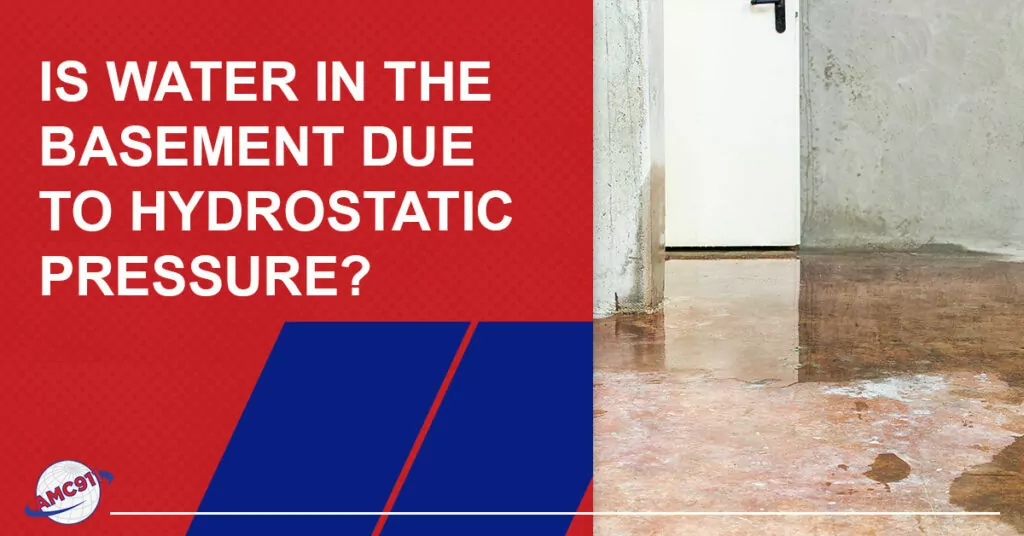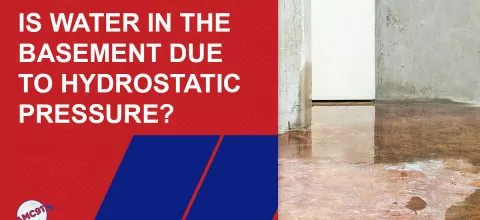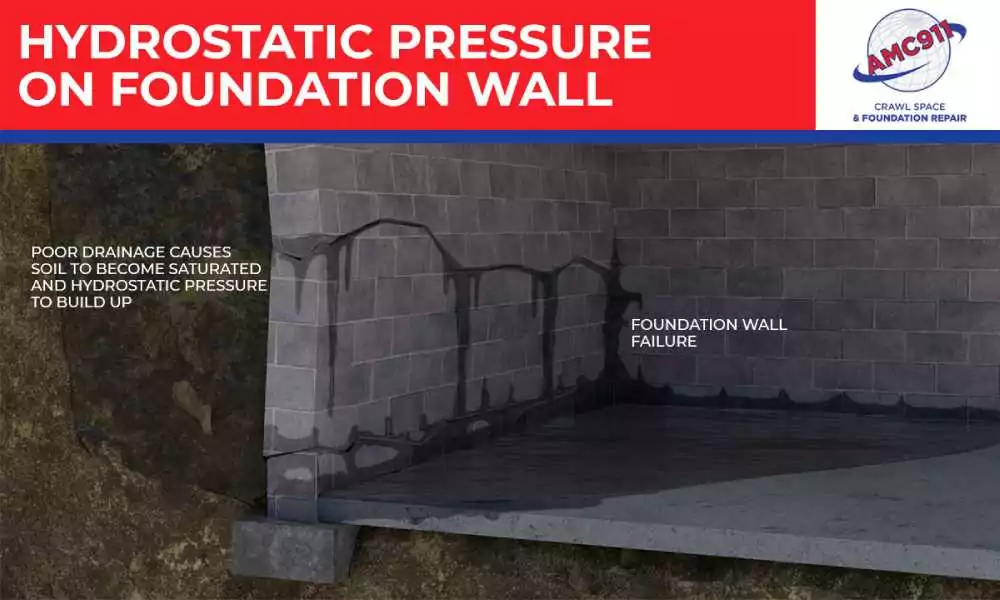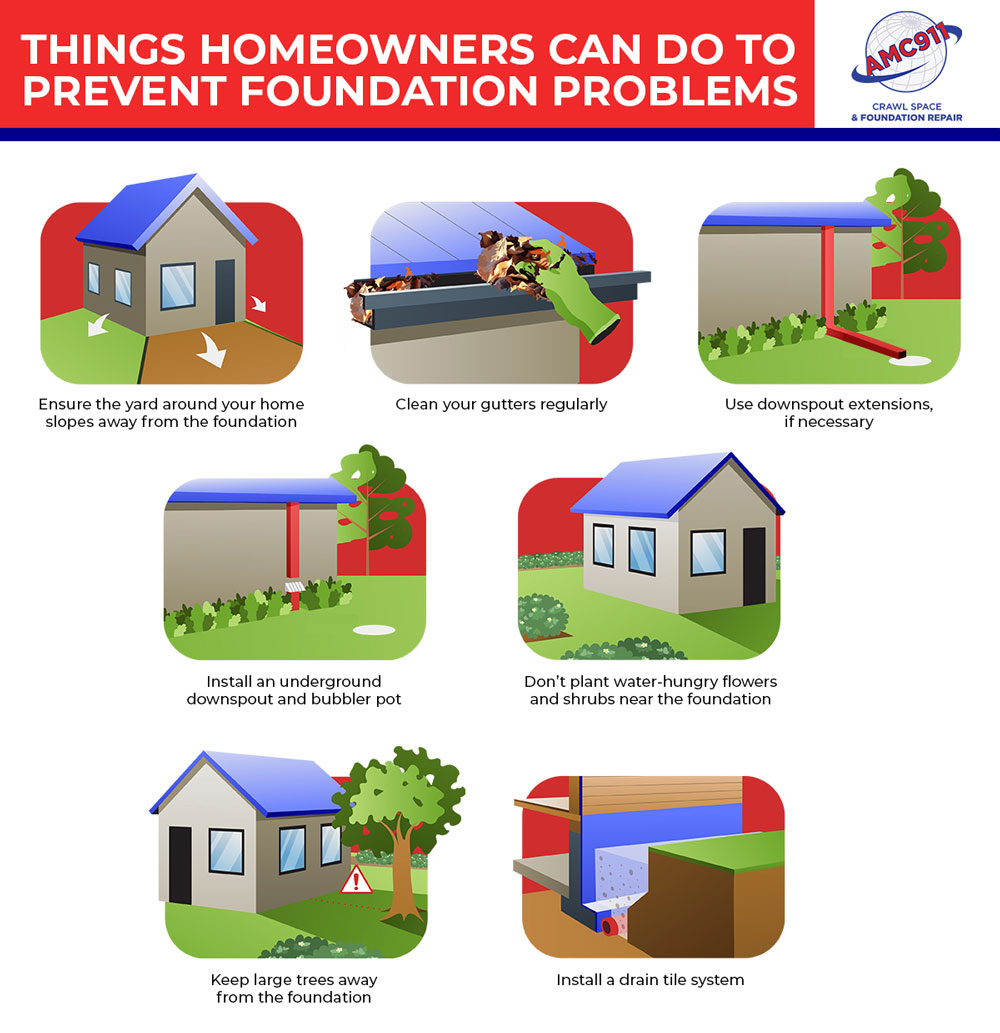Many homeowners with basement water problems are looking for a single reason why it is happening. Hydrostatic pressure is one of the most common reasons. However, there are other problems that may lead to water in the basement, including leaking basement windows, roof leaks, and plumbing problems.
Whatever the cause of the water in your basement, it should never be considered normal. It is a sign there’s a serious issue somewhere that must be fixed.
What Is Hydrostatic Pressure?
The term “hydrostatic pressure” describes the pressure that liquid exerts at rest. In this case, it would be the pressure placed on the foundation walls by the liquid in the soil surrounding them. It can also affect the foundation slab as well from underneath.
Hydrostatic pressure on the foundation can cause basement walls to bow and crack. Since water weighs over 1,600 pounds per cubic yard, the forces placed on the foundation are tremendous. Hydrostatic pressure can push water through even the smallest crack in the foundation walls or slab. It can also enter through the cove joint, which is the area where the basement wall meets the slab.
What Causes Hydrostatic Pressure?
Generally, hydrostatic pressure occurs when water builds up in the area near the foundation or under the slab. The following are some common reasons you may have excess water in that area.
- Poor Drainage: Water should be able to drain away from the home naturally in the soil and on the surface. This drainage is accomplished by having the proper slope that allows the water to run off to a lower-lying area away from the foundation walls. It can also be accomplished with a drain tile system.
- Roof Runoff: The water running off the roof enters the gutters and exits the downspout. This results in a significant amount of water leaving the downspout at a location very near to the foundation. This issue can be corrected with downspout extensions.
- Plumbing Leaks: A plumbing leak near the foundation can also lead to water buildup. It may go undetected for a long time before it is recognized and fixed.
Other Sources Of Water In The Basement
Hydrostatic pressure is a common source of water in the basement, but it is not the only reason. We will now discuss some other problems that could lead to water in the basement.
- Sump Pump Problems: If the sump pump is not operating properly, it could allow the water in the sump pit to overflow onto the basement floor. This could occur due to the float valve not being correctly set, a stuck check valve, or the sump pump no longer working.
- Leaking Windows: Any opening in the foundation walls could lead to water intrusion. The windows are a likely culprit and a common source of basement water. Leaking windows can be replaced, or a window well with a drainage system and a window well cover could be installed.
- Drain Tile Failure: If the drain tile system (interior or exterior) is damaged or not installed correctly, it could lead to basement flooding during heavy rains.
Are You Seeing Other Signs Of Foundation Problems?
Water in the basement is a common sign that foundation problems are occurring. So, if you have a wet basement, look around for other signs of a foundation problem. These include the following:
- Cracks in Drywall: The shifting of the foundation may put pressure on the home’s frame. The pressure could show as cracks appearing in drywall. Large or expanding cracks should be carefully watched. They may originate near the doors or windows and sometimes continue from the wall to the ceiling.
- Separating Walls and Floors: If the walls and floors begin separating, it is a sign that the foundation has a problem.
- Sticking Windows and Doors: The door and window frames may get out of alignment as a shifting foundation stresses the home’s frame. You may notice the doors and windows sticking as they open and close.
- Leaning Chimney: One of the first signs that may be seen when a foundation is settling is for the chimney to lean or separate from the home.
- Bowed or Cracked Walls: Hydrostatic pressure can cause the foundation walls to bow in and eventually crack. It doesn’t take a lot of hydrostatic pressure for this to occur. Even a slight amount of pressure could cause damage over time.
- High Humidity: The moisture level may rise in the basement, which could also cause it to increase elsewhere in the home. The stack effect causes this phenomenon. The stack effect pulls air from the basement to fill the void left as warm air rises and exits the house through the attic.
- Mold: High moisture levels in the basement can lead to mold formation. You may notice a musty smell, or it may be seen as black or orange stains on the surfaces in the basement.
Options To Reduce Hydrostatic Pressure
Hydrostatic pressure must be addressed and fixed before any foundation repairs occur. Those adjustments would include options to keep the water away from the foundation walls:
- Install a Drain Tile System: A drain tile system can be installed outside the foundation walls or under the basement slab. Excess groundwater is drained through the pipe and directed to a sump pit. When the pit fills with water a sump pump turns on and ejects it away from the foundation.
- Use Downspout Extensions: These are attached to the downspouts to carry the roof runoff several feet away from the foundation before release.
- Yard Grading: Grading the soil around the foundation to allow water to drain away from the home will reduce the water near the foundation walls.
- Clean Gutters Regularly: This will prevent water from spilling over, running down the side of your house, and soaking the ground around the foundation.
Foundation Repair Options
Once the underlying issue leading to hydrostatic pressure is addressed, more repairs may be needed to resolve a foundation problem.
- Wall Anchors: If the basement walls have been impacted, wall anchors can be installed to stabilize the wall and pull it back into position. Different types of wall anchors will be used, depending on the circumstances and the extent of the damage.
- Carbon Fiber Straps: Carbon fiber is so strong they use it to build commercial aircraft. These straps have the ability to stabilize a bowed and/or cracked foundation wall. Once you paint over them, they’re virtually invisible.
- Underpinning: When differential settlement is a problem, underpinning may be used. Steel push or helical piers are inserted into the ground until they reach stable soil or bedrock. After attaching the piers to the home, they will stabilize the structure and can even be used to raise the foundation using hydraulics.
If you have water in the basement or any signs of foundation problems, call AMC911 for a free foundation inspection.


















